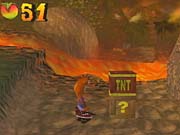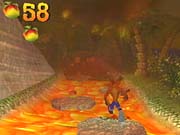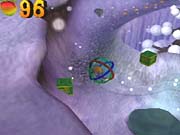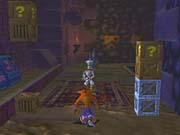Crash Bandicoot: The Wrath of Cortex Preview
We take a detailed look at the first non-Naughty Dog-developed Crash game.
Throughout its five-year history, the Crash Bandicoot series has remained surprisingly true to its roots. So far as the platformers in the series are concerned, the formula established by the first has remained untouched: As the spastic marsupial, you'll venture through 30 odd, similarly spastically designed levels, avoiding obstacles, spin-killing enemies, and collecting ton upon ton of fruit. In the latest game in the series--the upcoming Crash Bandicoot: The Wrath of Cortex--the song remains largely the same. But as anyone who's been following the game knows, the game is now in the hands of Traveller's Tales. So, has the UK-based developer done anything radical to Sony's once quasimascot?

If the latest build of the game is any indication, not really. Fans of the series will take comfort in the fact that Traveller's Tales seems to hold the game's tried-and-true formula in very high regard. If we use the current build as a blueprint for what's to come, we can expect a very familiar layout: Crash will journey throughout five worlds, engaging in the sort of linear, almost classical platform-style gameplay we've come to associate with him. There will be crystals to collect, to be sure (one was hidden in a demo stage we played), and possibly other types of key-type items, which you'll use to unlock levels previously locked. The levels themselves, if the current build is any indication, will come in two varieties: some that pay homage to classic platform gameplay, and others that are defined by self-contained vehicle-based sequences. There were two examples of the latter in the version we've been playing: one involved Crash flying around in an ultralight airplane, blasting enemies and tornado generators, while the other had him inside of an American Gladiators-style groundball. The mechanics of both were different enough from those of the standard levels, though not enough for you to feel jarred or jammed in. The one biggest change in this fourth Crash game, though, is the addition of the bandicoot's sister, Coco, as a genuine playable character that has her own levels to boot.

But the most welcome addition to the game, without a doubt, is the level of polish that Traveller's Tales has put into the game. Crash has never looked better, and his performance on the PS2 hardware is nothing short of silky. The game's levels are huge and well populated, abounding with graphical effects. Crash is wonderfully animated--nearly on the level, ironically enough, of Jak from Jak and Daxter. The frame rate, meanwhile, seems to be moving at a solid 60 frames per second, with the only hiccup occurring in the game's effects-heavy flight stage.
In short, the game seems well on its way to achieving the sort of technical polish that its 32-bit stepcousins enjoyed on the PlayStation. Some kinks exist, however; the game's mechanics feel a bit loose at times, resulting in a bit too many undeserved deaths. Also, there's a good deal of a guessing game that involves determining which attacks work against which enemies--something that, hopefully, will be ironed out before the game goes gold. In any event, we spent a good deal of time exploring the demo. Read on for impressions of what we saw.
Fans of platforms in the vein of Rayman 2 and Super Mario 64 will find one thing about The Wrath of Cortex unnerving: the fact that you die, in most cases, after getting hit once. The game does have a power-up that sucks up one blow for you, but when you're not this blessed, it's curtains after any sort of contact with an enemy or hazardous environmental element. While this is definitely in keeping with the game's adherence to the conventions of old, you often get the feeling that the game doesn't seem tuned for this type of thing. Some of the sequences, as a result, feel unreasonably difficult at this point. Couple this with the guesswork involved in defeating some of the enemies, and the game is often needlessly frustrating. Again, Traveller's Tales is hopefully aware of this and will make amends shortly.

The game's control scheme, in any case, is refreshingly simple. You move Crash (or Coco) by means of the D-pad or analog stick and make either of them jump with the X button. The circle button, meanwhile, executes the infamous screw attack, while the square button lets you perform a belly flop (a variation of the classic butt-stomp). Coco controls identically to Crash, but her animations are totally different. The control scheme works very well, and its command layout is very intuitive. If anything, it's a bit overresponsive; you'll often jump a bit too far, or else walk a bit too far, when you're near an edge.
During the vehicle sequences, the control schemes are suitable altered. The plane stage we played, for instance, maps all movement functions to the left analog stick, while the X button lets you fire your guns and the shoulder buttons let you execute defensive rolls. Movement with the plane is very simple--you simply point the stick in your desired direction and then move. The groundball mentioned earlier, on the other hand, is possessed by a set of Marble Madness-like mechanics. It is subject to momentum and is very responsive--you basically ease it into the direction you want to go. The level in which you'll use it comprises one of the more interesting segments in the demo we played--it takes place on a large, snowy downward slope that's littered with pits and deadly nitro crates. As you careen down the slope, you have to avoid the pits and nitro, all the while keeping mindful of what's ahead.
The straight-up platform stages, though, seem to be where the game is at its most frustrating. While most aspects of these stages seem well paced, every now and then, pure memorization seemed to be the only way of emerging victorious. It's hard to fault the developer for this, though; this type of thing goes on in most platform games, and gamers seem more than willing to deal with it.

But there are other piddling design issues that demand attention. For instance, the belly flop/spin-attack conundrum--some enemies seem vulnerable to only one, and there's nary an indication as to which one. The spearmen in the castle stage are a good example--spin into them, and you'll quickly die, though if you belly-flop them, you'll be OK. What's strange, though, is that they have spikes both on their weapons (which logically would cancel the spin attack) and on their heads (which would impale you before you could effectively flop them).
These sorts of things can really make a game feel broken, and it would be a shame if this latest Crash game suffered from them, as its technical production really is a testament to the skill of the developers. If the game's design were to only receive the same tender polish, Universal would have a definite hit on its hands. In any event, the game is set for release this holiday season.
Got a news tip or want to contact us directly? Email news@gamespot.com
Join the conversation